
* The Vulcan was a backbone of British nuclear strike capability through the 1960s, and remained in the nuclear strike role through the 1970s. It also served in the maritime reconnaissance role and as an interim tanker. Its only combat service took place in 1982, when a handful of Vulcan B.2s fought in the campaign to liberate the Falklands.
* The Vulcan B.2 began service carrying the Yellow Sun Mark 2 thermonuclear weapon. However, almost from the outset a rocket-powered standoff weapon, the Avro Blue Steel, had been planned for the B.2 fleet. It was a sleek dart of a missile, carried semi-conformally under the belly of a B.2 and powered by a liquid-fuel rocket engine system. The engine burned kerosene fuel with high-concentration hydrogen peroxide oxidizer, and used two thrust chambers -- one for initial boost, providing high thrust and fuel consumption, and one for cruise, with lower thrust and fuel consumption.
The Blue Steel could climb to 21,500 meters (70,500 feet) after release, reaching a maximum speed of Mach 2.3 before engine cutoff, and then diving towards the target; it had a stand-off range of 185 kilometers (115 miles). It was fitted with a megaton-range Red Snow warhead. The Blue Steel went into preliminary service in 1962, reaching full operational status in early 1963. Some sources claim that Vulcan B.2s that were modified to carry Blue Steel were given the designation of "Vulcan B.2A", but others say that it was the Olympus 301-powered machines that had this designation, and still others say the "B.2A" designation is a fiction.
The Blue Steel left a lot to be desired. The hydrogen peroxide oxidizer was extremely nasty, being both corrosive and toxic, requiring that crews handling it wear overall protective clothing and breathing apparatus. Getting a Blue Steel ready for a mission from a cold start was a time-consuming process, not exactly a good thing if Britain were under nuclear attack.
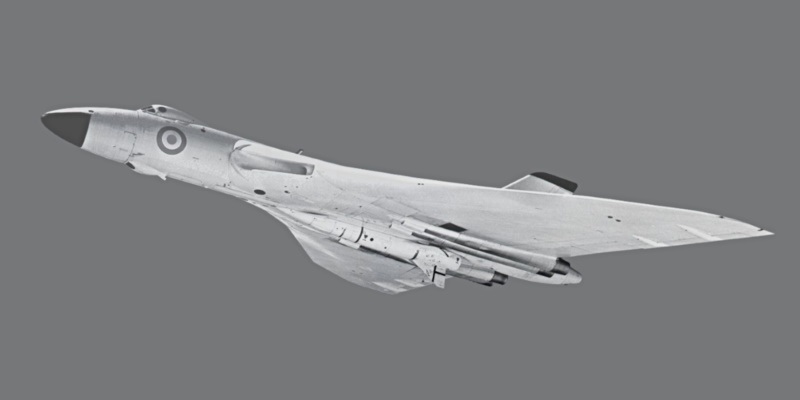
There was consideration of an improved Blue Steel Mark 2, but the RAF decided in 1960 to rest its hopes on a new American weapon, the Douglas AGM-87A Skybolt. The Skybolt was to be a marvel of sophistication, an air-launched ballistic missile with a range of at least 1,600 kilometers (1,000 miles). Two Vulcan B.2s were fitted with a pylon under each wing to carry a Skybolt and participated in trials. Late production Vulcans had hardpoints for the Skybolts, along with ducts for a cooling system required by the Skybolt, and it appears this kit was also retrofitted to some earlier B.2s. The expectation was that the Vulcan B.2 would be followed by a "Vulcan B.3", with a further enlarged wing, a fat extended spine to carry more fuel, and a load of six Skybolts.

Then the whole thing went south abruptly. The Skybolt was very complicated, with the first five test launches ending in failure. The US canceled the Skybolt program in December 1962 even though a successful test flight had been conducted only shortly before. It appears that the problems were not regarded as complete show-stoppers, but had simply highlighted the fact that other new US nuclear assets -- including the Minuteman intercontinental ballistic missile (ICBM), the Polaris submarine-launched ballistic missile (SLBM), and the supersonic Hound Dog air-launched cruise missile -- could do the job, and so there was no point in pumping more money into Skybolt.
The problem for the UK was that the US publicly announced the cancellation with no warning to the British government. Realizing the error, the Kennedy Administration offered to continue the Skybolt effort as a joint program; transfer the program to the UK; provide Hound Dog; or provide Polaris SLBM technology. Any analysis of the options made the choice obvious: Polaris was already in service with the US, and a Polaris submarine could operate on a mobile alert status for months at a time, carrying 16 missiles. The British decided that Skybolt didn't make any sense for them, either, and opted for Polaris.
The cancellation of Skybolt meant that the Vulcan would never carry the missile in service. Incidentally, along with the hardpoint under each wing for the Skybolt, there are rumors that a second hardpoint was added under each wing, at least with some machines, permitting attachment of four stores pylons. Whatever the case, Vulcans were never fitted with more than two stores pylons in practice.
BACK_TO_TOP* The abrupt end of the Skybolt program meant rethinking the V-bomber force. The Vulcan had originally been designed as a high-altitude bomber, relying on height for defense, but the shoot-down of a US Lockheed U-2 spyplane over the USSR on 1 May 1960 by an SA-2 surface-to-air missile had demonstrated the days of high-altitude bombing were over. Skybolt would have given the Vulcan the ability to strike targets deep in the USSR from well outside defended Soviet airspace, but now some other plan had to be developed.
The plan was low-level bombing, cruising at altitude to enemy airspace and then penetrating "down on the deck". Crews would train to fly below 300 meters (1,000 feet) initially, then learn to fly at 150 meters (500 feet), with aircraft captains going even lower, as low as 15 meters (50 feet), depending on their skill and nerve. The switch to low-level tactics was why plans to refit the Olympus 201-powered B.2s to the Olympus 301 were canceled, there being no great need for the additional power at low level.
The all-white color scheme was obviously no good any more, so a disruptive pattern of gloss dark green and sea gray was painted on top, with the anti-flash white retained on the bottom. The new color scheme was implemented from the spring of 1964. Avionics improvements were also provided to the B.2:
It is unclear if any of these updates were provided for the B.1As. Weapons carriage had to be reconsidered as well. Blue Steel remained in service for the time being, being adapted to low-level operation by using both thrust chambers for initial boost to altitude, at the cost of halving range. The Yellow Sun Mark 2 was also retained -- but it required that the bomber climb to altitude before release, which was obviously unsatisfactory.
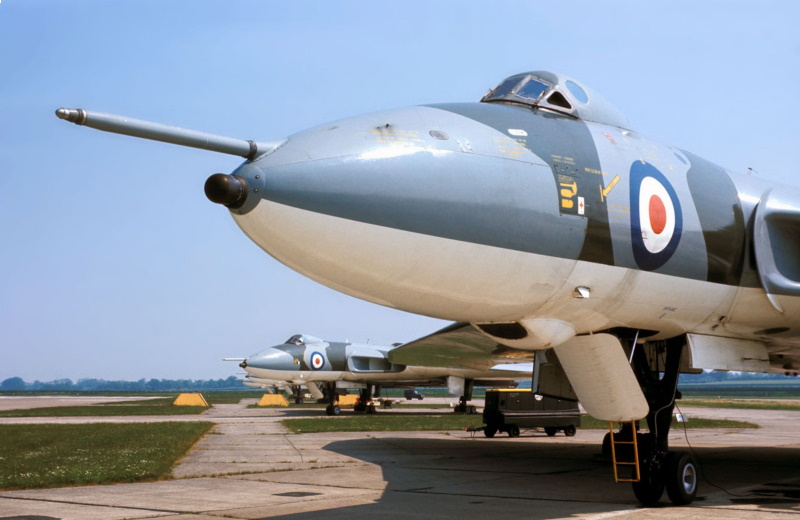
A new parachute-deployed tactical nuclear weapon, the WE177A, was seen as adaptable to the low-level nuclear strike role, and an uprated variant, the WE177B, was developed, to be introduced in 1966. The WE177B had a yield of about 400 kilotons, twice that of the WE177A, and only weighed about 430 kilograms (950 pounds), allowing the Vulcan to carry a devastating warload, at least in principle. The Yellow Sun Mark 2 was retired a short time later. Of course, conventional bombs with parachutes or other "retarders" could be carried as well.
Armed with new tactics and weapons, Vulcans remained on QRAs through the 1960s. Converting to low-level tactics meant that the Vulcan's big wing now worked against it, making the aircraft sensitive to air disturbances and resulting in a bumpy ride. However, it was very rugged and well able to tolerate low-altitude flight.
* Polaris came on line in 1969 and that was the end of Vulcan QRAs, with the antiquated Blue Steel retired as well. The B.1A fleet had been retired or passed on to secondary roles by this time as well, the last being removed from frontline service in 1968. That wasn't the end of the Vulcan fleet by any means; the Vulcan B.2 was retained in service in the low-level bombing role -- featuring some improvements, such as an ARI 18228 RWR, fitted in a distinctive box fairing on top of the tailfin, with the refit program beginning in 1975.
The B.2 was even deployed overseas on a long-term basis, with 16 B.2s of Numbers 9 and 35 Squadrons being sent to Akrotiri airfield on Cyprus in 1969 to provide a British strategic presence in the Mideast. These aircraft were able to operate from satellite bases in Bahrain and Oman; they were armed with the Red Beard tactical nuclear weapon, or conventional bombs. The B.2s remained stationed on Cyprus until 1974, when the Turkish invasion of the northern part of the island made flight operations from Akrotiri more troublesome. The Vulcans went back to Britain, though four-ship detachments still continued to visit Cyprus on a regular basis.
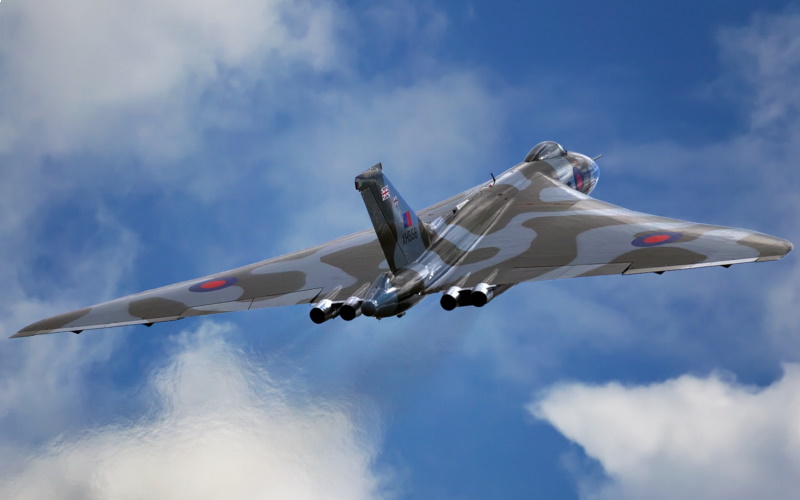
The Vulcan paint scheme was modified in 1972, using a disruptive pattern of flat dark green and medium gray on top and light gray on the bottom. In 1977, Vulcans began to participate in the US "Red Flag" wargame exercises over the deserts of the US southwest; these machines were painted in an overall disruptive scheme of sand and brown, and occasionally wore their desert colors back in the UK. A similar scheme seems to have also been applied at least to some Cyprus Vulcans, though the underside remained painted in light gray.
* The Vulcan B.1 and B.1A, though retired, were still making themselves useful during this era. As mentioned, B.1s pulled from frontline service were sometimes used for trials, with the high ground clearance and heavy payload capability making the type a very useful platform for engine testing, the engine being slung under the aircraft centerline.
The first such fit involved a B.1 carrying the Olympus 22R afterburning turbojet for the ill-fated BAC TSR.2 Mach 2 low-level strike aircraft. The engine installation featured a split intake to give room for the Vulcan's nosewheel. Initial flight in this configuration was on 23 February 1962, but the engine caught fire and the aircraft burned up on the runway on 3 December 1962. Fortunately, the crew escaped without injury.
There were plans to use a Vulcan to test the Bristol BS100 vectored-thrust engine for the Hawker P.1154, which was more or less a Mach 2 cousin of what would become the Hawker Harrier "jump jet", but the P.1154 program ended up being canceled. The Olympus 593 afterburning turbojet for the Concorde supersonic transport was successfully trialed on a Vulcan B.1, with initial flight in the test configuration on 9 September 1966.

The same B.1, XA903, was then used to test the TurboUnion RB199 turbojet for the Panavia Tornado low-level strike aircraft, with the test installation also including a cannon fit on the engine nacelle, likely to test for engine gun gas ingestion. Flight trials began in early 1976. AX903 performed the last flight of a Vulcan B.1 on 22 September 1979. No Vulcan B.1/B.1A bombers have survived as museum pieces.
BACK_TO_TOP* The introduction of the Polaris force did mean a reduced need for long-range bombers, and so in 1973 Number 27 Squadron was reformed as a maritime radar reconnaissance (MRR) operation. The squadron operated a total of eight Vulcan B.2s modified to "Vulcan B.2MRR" spec by addition of a LORAN-C navigation receiver, along with removal of the AN/APN-171 TFR system and the thimble radome. The H2S Mark 9A radar was perfectly adequate for the maritime reconnaissance search role, though it was modified for the new job, presumably with a new antenna. The standard Vulcan strike camera was modified to obtain photographic intelligence, with the crew also using a commercially-obtained hand-held camera when necessary. The crew would call in a smaller strike aircraft like a Blackburn Buccaneer if the target needed "up close and personal" attention.
Five of the machines were fitted with pylons to allow them to carry air-sampling pods, fitted with filters to trap fallout and other atmospheric contaminants, with the pods modified from drop tanks. The Vulcan B.2MRR fleet retained the gloss paint scheme, since it improved resistance to corrosion. Incidentally, some sources refer to the Vulcan B.2MRR as the "Vulcan B.2SR" or something along such lines, the "SR" standing for "strategic reconnaissance", but this is incorrect.
* By the mid-1970s, the Vulcans were becoming weary and the entire Vulcan force was headed for retirement after the end of the decade, to be replaced in the low-level role by the Tornado GR.1. However, in April of that year, the Vulcan was called into combat for the first and last time, in the eleventh hour of its career, to fight in combat.
The British Falkland Islands in the South Atlantic had just been occupied by forces of Argentina's military junta. Public support for military rule there had been fading, and so the leadership decided to engage in popular theatrics. Argentina had never been happy about Britain's long-standing occupation of the Falklands -- or Malvinas, as the islands are known in Argentina -- and it seemed simple enough to just grab them. The islands were small, the main industry being sheepherding, and the British would find conducting a military campaign over such enormous distance expensive and risky.
Obviously, Britain would do no more than squawk. That was underestimating the will of British Prime Minister Margaret Thatcher in a way that even her most contemptuous enemies back home wouldn't have considered, and after ultimatums were ignored, Britain's military machine went into high gear, throwing together a counter-invasion fleet in a round-the-clock effort.
The Vulcan was also seen as a useful asset for the conflict. Five B.2s were selected to fly under Number 101 Squadron in the BLACK BUCK campaign, as it was codenamed, with a mad scramble to get the aircraft ready for operation. The idea was to operate the Vulcans out of Wideawake airfield on Ascension Island in the mid-Atlantic for strikes on the Falklands. Even from Ascension, it was a long journey and Victor tankers would be needed in stages to provide inflight refueling support.
Vulcans had rarely if ever performed inflight refueling since the end of QRA, the concept not being necessary under the tactical operational doctrine in effect -- and not only were crews untrained in the procedure, the inflight refueling gear was in a nonfunctional and, in some cases, incomplete state. Getting it into working condition was put on the top of the priority list, with a Vulcan on static display at Castle Air Force Base in California even looted for components. Aircrews trained at inflight refuelings, including night refuelings. It wasn't possible to get everything working perfectly, with fuel spills from the creaky refueling system flooding the windscreen, but a set of flanges were improvised and fitted on the nose of each aircraft to splash away the spilled fuel. A sixth crew member was added for the BLACK BUCK missions to help with the multiple refuelings.
All the B.2s selected for the campaign were those built with Olympus 301 engines. The engines had been thrust-limited to 90% maximum to extend operational life, but the limiters were now removed. The five B.2s also had pylon hardware; since the existing countermeasures system didn't completely blanket Argentine defensive radars on the Falklands, a US-built AN/ALQ-101 jammer pod obtained from the Buccaneer fleet was fitted to one pylon. In addition, the aircraft were fitted with a Carousel inertial navigation system, scavenged from retired Vickers Super VC10 airliners, and were painted dark gray underneath for night bombing.
The initial mission in the series, BLACK BUCK 1, was performed on 30 April:1 May 1982, with a Vulcan B.2 under the command of Flight Lieutenant Martin Withers flying from Ascension to come in towards the Falklands at low level, then pop up to drop a full string of 21 450-kilogram (1,000-pound) bombs across the runway of Port Stanley airport. The mission covered a round-trip distance of 12,070 kilometers (7,500 miles) and lasted almost 16 hours. It involved two Vulcan bombers, one as a backup, and 11 Victor tankers in all.
Only one bomb from the Vulcan that made the full trip actually hit the runway -- but the thunderous bombardment did make a discouraging impression on Argentine forces on the Falklands, and also intimidated the military junta into pulling back resources to the defense of the Argentine mainland. BLACK BUCK 2 was a similar mission on 3:4 May, but failed to hit the runway, though again the bombardment further discouraged Argentine troops. BLACK BUCK 3 was scheduled for 16:17 May, only to be canceled when weather forecasts indicated headwinds that would have made reaching the objective difficult.
* Now the focus shifted to attacks with anti-radar missiles (ARMs) to provide "defense suppression" for RAF and Royal Navy aircraft operating with the Falklands invasion fleet. The initial idea was to use the Martel AS37 ARM, one under each wing on a pylon, and a test firing in early May demonstrated that it was practical. However, there were doubts that the Martel could survive a long, cold, high-altitude flight in working condition.
The Americans were officially neutral in the conflict, but along with the influence of the "special relationship" between the two countries, the US had no sympathy with the Argentine military junta. A senior US government official who went to Argentina in a pointless attempt to talk things out early in the crisis described the leadership as "a gang of thugs with no one clearly in charge." The US had been supplying detailed intelligence to the British as well as the leading-edge AIM-9L Sidewinder air-to-air missile -- with "all-aspect" capability, meaning the missile didn't have to be targeted on engine exhausts -- which proved lethally effective against Argentine Mirages and Skyhawks in the hands of Royal Navy Sea Harrier pilots. The Americans also provided the AGM-45 Shrike ARM, which was fitted two to a pylon under each wing, the carriage scheme having been hastily improvised.
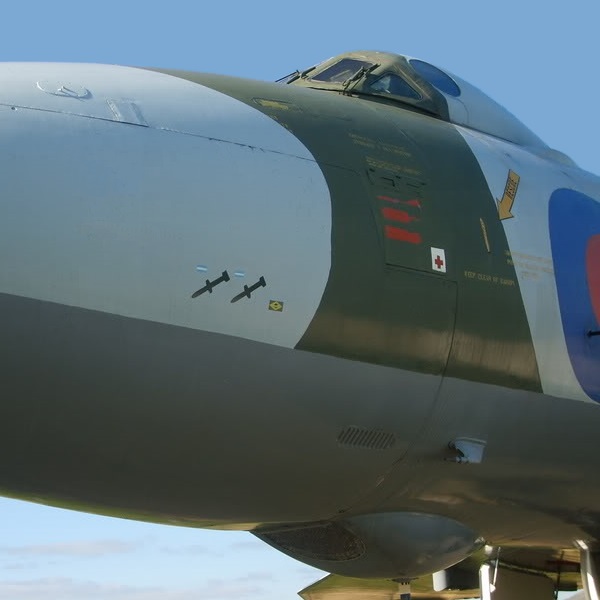
It was something of a comical-looking fit, with such a big aircraft carrying a warload of four little missiles, but it was what worked. There were also ideas about carrying Sidewinders on the pylons for self-defense and intriguing tests for carriage of laser-guided bombs in the bomb bay -- with a laser target designator fitted in the long-unused bomb-aimer's blister under the nose -- though nothing came of such schemes.
BLACK BUCK 4, the first Shrike mission, was initiated on 28 May, but had to be canceled due to tanker malfunctions. BLACK BUCK 5 on 30:31 May involved a Vulcan carrying two Shrikes, but failed to score a radar kill. BLACK BUCK 6 on 2:3 June involved a Vulcan with four Shrikes and scored a hit. The AN/ALQ-101 pod wasn't carried on the ARM strikes because the idea was to encourage the Argentines to turn on their radars so they could be targeted.
The BLACK BUCK 6 aircraft suffered a damaged inflight refueling probe during the mission and was forced to land in Rio de Janeiro after the strike, carrying one Shrike that the crew hadn't been able to discard, and so low on fuel that a second go-round for landing was out of the question. The Brazilians impounded the Shrike, refueled the bomber, and allowed it to fly off on 10 June. The Brazilian government submitted a formal protest to the British government over the violation of neutrality.
* The final mission, BLACK BUCK 7, was on 11:12 June 1982, with a Vulcan dropping a string of airburst bombs directly over Argentine troops. The Argentine ground forces had never been highly motivated and had effectively been abandoned to their fate; the Falklands were secured by British forces within a week. The Argentine military junta, their bid to shore up popular support having disastrously backfired, soon collapsed, and democratic government was restored. The BLACK BUCK missions had been more bark than bite, causing relatively little material damage for all the thunder -- but the bark was loud and intimidating, and the effort was considered an important element in the final satisfying British victory.
BACK_TO_TOP* The Vulcan performed its last flight in bomber service in December 1982, when Number 44 Squadron stood down. The remote facility at Offutt AFB had been shut down in 1982 as well. That wasn't quite the end of the story, however. The Falklands conflict had strained tanker resources, and though the RAF was acquiring old Vickers VC10 airliner airframes for conversion into tankers, the lead times on the effort were too far out to plug the immediate shortfall. In 1982, the decision was made to hastily convert six Vulcan B.2s to an interim tanker configuration, using Flight Refueling Limited Mark 17B hose-drum units (HDUs) intended for the VC10 tanker program.

The original idea had been to fit an HDU into the bomb bay of each aircraft, but it proved unworkable for various reasons -- and so the actual fit involved cleaning out the ECM gear from the tailcone, then shoe-horning the HDU underneath. The effort took seven weeks from startup to redelivery of the first "Vulcan K.2". -- initially designated "Vulcan B.2(K)" -- to the operator, Number 50 Squadron, the only Vulcan squadron to survive the 1982 phaseout.
The bomb bay of each K.2 was filled with three fuel tanks providing 4,546 liters (1,200 US gallons / 1,000 imperial gallons) capacity each. The HDU was controlled by a periscope from the coal hole. The aircraft retained camouflage colors except for being painted white in a broad strip up the belly and across the bottom rear of the wing, with alignment markings added to help clients line up for refueling. Floodlights were fitted to support night refueling, and some sources say that a transponder was installed to help clients find the tanker. Number 50 Squadron also operated three "stock" Vulcan B.2s for training purposes.
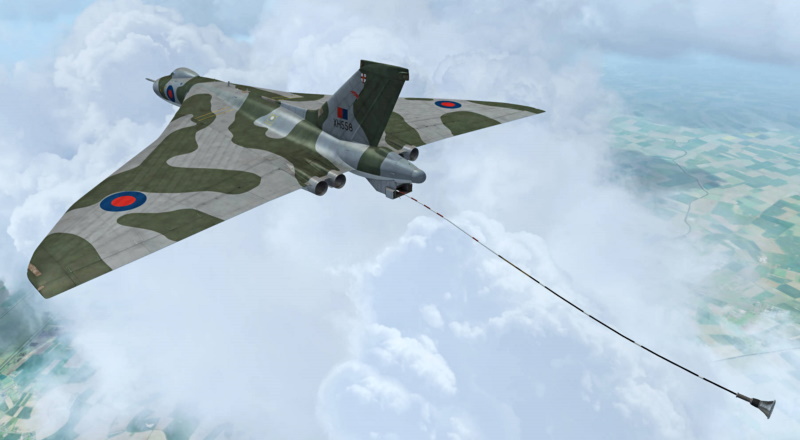
* The tankers were retired in the spring of 1984, when the HDUs were yanked to be put into the VC10s for which they had originally been intended. That was not quite the end of the V-bomber force, the Victor tanker remaining in service long enough to serve in the Gulf War in 1990:1991, to finally be phased out of service in 1993.
The RAF retained two B.2s in flying condition as part of the "Vulcan Display Flight", performing airshow flypasts, but money ran out, and the Vulcan performed its last flight in RAF service on 23 March 1993. It was the Vulcan B.2 XH558, which had served both as a Vulcan B.2MRR and K.2. It performed the final flight with the word FAREWELL painted on its open bomb bay doors. It is said some spectators wept.
About 20 Vulcan B.2s survive in the UK and elsewhere. Few thought any would ever be seen in the air again, but a dedicated group of restorers at Bruntingthorpe in the UK, a retired USAF air base, obtained millions in funding from 20,000 donors around the world, restored B.2 XH558 to flight condition, with the machine taking off on a 20-minute flight on 18 October 2007. It continued flight operations at airshows until 2015, when airframe life issues finally made it too risky.
BACK_TO_TOP* Although the Vulcan was the only jet bomber actually built by Avro, the company considered designs for others.
The three V-bombers were all originally built for the high-altitude bombing role. In 1952, while the Vulcan was performing its first flights, the Air Ministry requested preliminary concepts for a "Low Altitude Bomber (LAB)" to complement the high-altitude bomber force, with the LAB penetrating enemy defenses at an altitude of about 150 meters (500 feet) at close to Mach 1.
General concepts were submitted by most of Britain's aircraft manufacturers. The Avro proposal was the "Avro 721", and was in the form of a canard machine with a small, cranked-delta wing. Powerplant options included four projected Napier NP.172 turbofans or two Rolls-Royce Conway turbofans. The small wing made getting off the runway with a full warload troublesome, and so built-in rocket boosters were considered. The bomb was to be ejected backwards through doors in the rear.

The LAB concepts submitted by the manufacturers were given a looking-over; meetings were conducted in 1954 on moving to a full requirement specifying an operational aircraft, but the studies indicated that a LAB would require considerable effort and involve high risk. The aircraft demanded a high strength-to-weight ratio, new navigation systems, new weapons and associated delivery schemes, and so on. The cost of development was estimated as high as 15 million pounds -- a modest sum for development of a combat aircraft these days, even adjusting for inflation, but a major expense for those days, and more than the budget could bear. The conclusion was to not seek an operational system.
Since the V-bombers ended up operating at low level anyway, the decision not to proceed comes across as a lost opportunity, but LAB really was pushing the state of the art. The Royal Navy did obtain a low-altitude tactical bomber in the early 1960s, the superlative Blackburn Buccaneer, which the RAF would adopt as well -- though only because all alternatives got the axe. The RAF was not happy about the Buccaneer at first, but once in service it proved an outstanding combat aircraft.
* Following the LAB exercise, the RAF came fairly close to obtaining a Mach 2+ V-bomber, the "Avro 730", and it remains one of the tantalizing "might have been but wasn't" machines in British aviation history.
In early 1955, after some months of drafting specifications, the Air Ministry issued a request for proposals to meet a requirement for a new strategic reconnaissance aircraft, intended to map targets for Britain's V-bomber force. The specifications were extremely aggressive, dictating an aircraft that carried both photographic and radar reconnaissance payloads, operating at a speed of Mach 2.5 at an operating altitude of at least 18,300 meters (60,000 feet) over a range of 9,265 kilometers (5,000 NMI). The machine was to be ready by 1960; the Air Ministry was willing to consider acceptance of an interim type built to a less demanding spec if further development would provide an improved variant that did all that was asked.
Designs were submitted by Avro, English Electric, Handley-Page, Shorts, Vickers, and Saunders-Roe. Avro won the award in September 1955, with a contract signed in November of that year for the "Avro 730". By this time, the specification had been expanded, with the aircraft to be used in both strategic reconnaissance and strategic nuclear bombing roles.
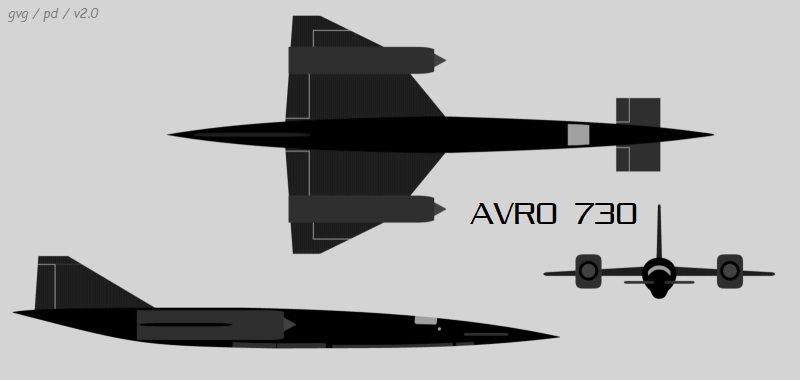
As it emerged, the Avro 730 was a canard design, with a simple rectangular foreplane on the nose; a cranked delta wing towards the rear, with an engine nacelle mounted in the middle of each wing; and a swept tailfin. It was not a small aircraft, with a length of 49.8 meters (163 feet 7 inches) and a loaded weight of 101,000 kilograms (222,660 pounds). Construction was to be mostly of steel honeycomb sandwich, steel being chosen over aluminum because of the high friction heating at a cruise speed of Mach 2.5.
The landing gear was more or less of a bicycle configuration, with small twin wheels towards the nose, four large wheels in a 2x2 configuration under the rear fuselage, and a tandem twin-wheel outrigger under each engine nacelle. Powerplants were to consist of eight Armstrong-Siddeley P.176 turbojets, with a maximum thrust of 62.2 kN (6,350 kgp / 14,000 lbf) each, arranged with four in each nacelle in a 2x2 pattern. Aircrew consisted of a pilot and navigator, flying side-by-side under a flat windshield panel and with a small porthole on each side. Payload included a Red Drover side-looking airborne radar (SLAR), with the antennas embedded in the fuselage back from the nosewheel; plus a total of 2,725 kilograms (6,000 pounds) of stores in a weapons bay behind the SLAR antennas and forward of the mainwheel.
The Avro 730's configuration was very unusual and plans were made to build a 3/8ths-scale single-seat demonstrator, the "Avro 731", as a risk-reduction exercise. Up to four Avro 731s were to be obtained, with various powerplant configurations under consideration.
By early 1957, the Avro 730 was scheduled to be in RAF service by 1965, longer than had been hoped at the outset, but not unreasonable given the advanced nature of the aircraft. Thought was already being given to a follow-on ... then the program abruptly imploded.
In April 1957, Defense Minister Duncan Sandys (pronounced "Sands") published his infamous defense "White Paper", which said that manned aircraft were obsolete and that missiles were the way of the future. Although this conclusion would prove to be very much an exaggeration, in Sandys' defense such an attitude was also evident to a greater or lesser extent in the USA and USSR at the time. In addition, the ultimate collapse of Britain's imperial ambitions in the wake of the 1956 Suez crisis meant that the UK needed to downsize the nation's defense industries. However, the "Sandystorm", as it was called, did not result in a "soft landing" so much as it led to wreckage strewn across the landscape, with widespread cancellations taking the wind out of Britain's aerospace industry for years.
The Avro 730 got the chop before the month was out. In hindsight, some really intriguing aircraft development efforts were killed off in the Sandystorm, but the cancellation of the Avro 730 is a harder call. With the arrival of ICBMs, a Mach 2.5 high-altitude bomber was arguably redundant, and a useless expense for Britain. Still, from a technical point of view it was a pity that the Avro 730 never flew: it looked like it would have been a really impressive flying machine, not so far off the lines of the slightly later US Lockheed SR-71 Blackbird, and a major achievement for British aerospace engineering.
BACK_TO_TOP* In sum, a total of 136 Vulcans was built, variants including:
* The Vulcan is one of the few RAF aircraft I've ever seen flying in service. As mentioned, the British V-bomber force worked hand-in-glove with America's SAC. There was a SAC base, Fairchild AFB, outside my hometown of Spokane, Washington, and one day my mother was driving me along the highway when we confronted two or three Vulcans flying low over the hills. I don't have anything resembling a photographic memory, and it's all very vague after so many decades, but I do recall that, as an airplane geek from an early age, I was thoroughly excited.
I spotted a Vulcan at the US Air Force Museum in Dayton, Ohio, during a visit in the 1990s. It was sitting in the open, looking very tattered and sad. I visited again a few years later and the Vulcan was gone, but on the same trip I visited the Strategic Air & Space Museum in Nebraska and spotted a Vulcan, likely the same one, waiting its turn to be restored to its former glory.
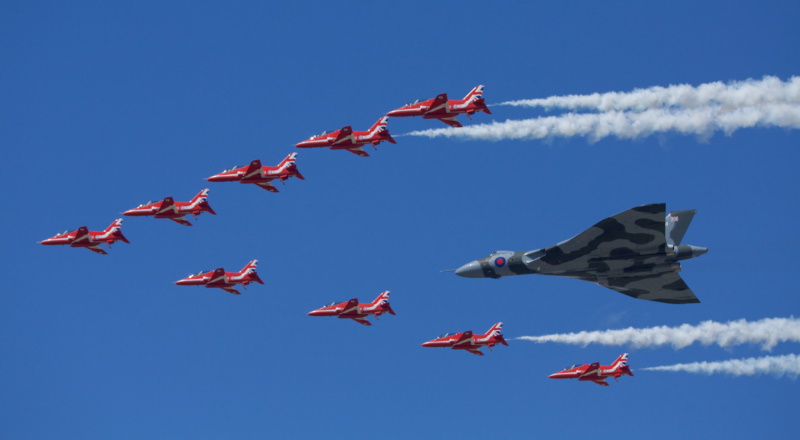
* Sources include:
* Illustrations credits:
* Revision history:
v1.0.0 / 01 oct 06 v1.0.1 / 01 nov 07 / Vulcan return to flight. v1.0.2 / 01 oct 09 / Review & polish. v1.0.3 / 01 sep 11 / Review & polish. v1.0.4 / 01 aug 13 / Review & polish. v1.0.5 / 01 jul 15 / Review & polish. v1.0.6 / 01 jun 17 / Review & polish. v1.0.7 / 01 may 19 / Review & polish. v1.1.0 / 01 sep 21 / Illustrations update. v1.1.1 / 01 dec 21 / Review & polish. v1.1.2 / 01 dec 23 / Review & polish.BACK_TO_TOP
